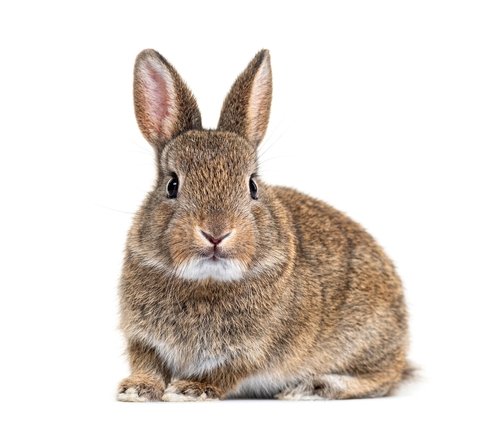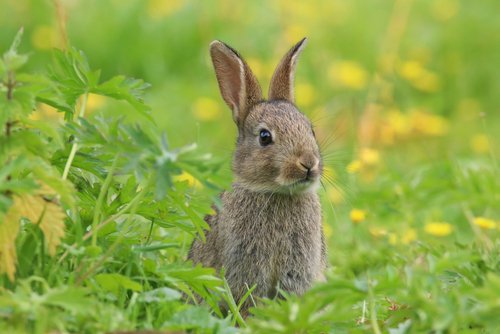Rabbit Species – Don’t Miss Out on the Volcano Rabbit
A fascinating world unfolds when we delve into the realm of rabbit species, where a group of small mammals that have captivated our imaginations and earned their place in folklore and literature throughout history. Defined by their long ears, powerful hind limbs, and propensity for leaping, rabbits belong to the family Leporidae within the order Lagomorpha.
These herbivorous creatures have evolved an array of adaptations to survive in various habitats across the globe. From the European rabbit to the Snowshoe hare and lesser-known species like the Volcano rabbit and Amami rabbit, this article will delve into the captivating diversity of different types of rabbits.
Definition of a Rabbit
Rabbits are members of the family Leporidae, characterized by their small to medium-sized bodies, long ears, short tails, and strong hind legs designed for swift movement. They are herbivores with specialized teeth that continuously grow throughout their lives—a feature vital for efficiently processing tough plant material. Rabbits typically have 28 teeth comprising incisors that enable them to gnaw on vegetation and molars at the back of their jaws for grinding food.
Their keen senses help them detect potential threats from predators while simultaneously locating food sources. These furry mammals also possess remarkable agility when leaping swiftly away from danger.
Overview of Rabbit Species Diversity
The vast diversity within the rabbit family is truly remarkable. While there are over 50 recognized species belonging to various genera within Leporidae, this article will focus on some prominent examples such as Oryctolagus cuniculus (European rabbit), Sylvilagus floridanus (Eastern Cottontail), Lepus americanus (Snowshoe hare), Romerolagus dizi (Volcano rabbit), Pentalagus Furness (Amami rabbit), and Brachylagus idahoensis (Pygmy rabbit). Each species possesses unique characteristics, adaptations, and ecological roles that contribute to tour planet’sfascinating tapestry of rabbit biodiversity.
Major Rabbit Species
European Rabbit (Oryctolagus cuniculus)

The European rabbit, scientifically known as Oryctolagus cuniculus, is a widely recognized species that is the ancestor of most domesticated breeds. These rabbits showcase a compact and robust body structure, measuring around 40 to 50 centimeters in length.
They possess soft fur in various colors, including brown, gray, and white. One notable physical feature of the European rabbit is its long ears, which are charming and aid in detecting potential predators.
The habitat range of European rabbits extends across several continents, including Europe and parts of North Africa. They are adaptable creatures that can thrive in diverse environments such as grasslands, forests, and agricultural fields.
However, these rabbits prefer open spaces with ample vegetation cover where they can burrow safely. European rabbits tend to be highly social animals regarding behavior and social structure.
They form complex hierarchical systems within colonies known as warrens or burrows. These burrows provide essential protection from predators and serve as communal nesting places for breeding females.
Eastern Cottontail (Sylvilagus floridanus)

The Eastern cottontail (Sylvilagus floridanus) is a predominantly native species in North America. This medium-sized rabbit species showcases an adorable appearance with soft fur ranging from reddish-brown to grayish-brown hues.
One distinguishing feature of the Eastern cottontail is its fluffy white tail resembling a cotton ball. Eastern cottontails display remarkable adaptability regarding their habitat preferences and range distribution.
They are commonly found across various habitats like woodlands, brushy areas, meadows, and even suburban neighborhoods throughout the eastern United States and parts of Mexico and Canada. These rabbits are known for their preference for areas with dense vegetation cover, providing them with sufficient hiding spots from predators.
As for reproduction and life cycle, Eastern cottontails have a high reproductive capacity. Females can produce several litters yearly, with each litter comprising around three to eight offspring.
They construct nests known as forms in grassy areas or burrows where newborns are born blind and hairless. The young rabbits, also called kits, grow rapidly and become independent within a few weeks.
Snowshoe Hare (Lepus americanus)

The Snowshoe hare (Lepus americanus) is a fascinating species renowned for its unique adaptations to snowy environments. This medium-sized hare boasts an elegant appearance with large hind legs that aid in swift movement over snow-covered terrains. Its fur changes color seasonally: brown in summer to blend with the forest floor and white in winter to camouflage against the snow.
The Snowshoe hare has a broad geographic distribution across North America, particularly in boreal forests and mountainous regions. Their habitat selection centers around dense brushy areas with ample food sources such as twigs, buds, and bark.
Interestingly, these hares possess large hind feet equipped with tufts of stiff hairs that act like natural snowshoes, allowing them to stay buoyant on top of the snow while traversing their habitat. Predation strategies play a crucial role in the population dynamics of Snowshoe hares.
They have evolved remarkable agility and speed as defense mechanisms against predators such as lynx, coyotes, and birds of prey. Additionally, these hares exhibit fluctuations in population densities due to cyclic patterns influenced by predator-prey relationships and food availability.
Lesser-Known Rabbit Species
Volcano Rabbit (Romerolagus diazi)
The Volcano Rabbit, also known as the Teporingo, is a fascinating rabbit species that is endemic to Mexico’s volcanic regions. This small rabbit inhabits the higher elevations of central Mexico, particularly in the dense vegetation surrounding volcanic slopes.
Weighing only around 500 grams (1.1 pounds), they are one of the smallest rabbits in the world. However, their diminutive size does not make them any less important regarding ecological significance.
The Volcano Rabbit faces significant threats to its survival due to both natural and human-induced factors. Habitat loss resulting from agricultural expansion and urbanization is a major concern, as it diminishes their already limited range.
Additionally, climate change poses a considerable threat since these rabbits adapt to cooler temperatures at higher elevations. Conservation efforts have been put in place to protect this species, including establishing protected areas such as national parks and reserves dedicated to preserving their habitat.
Amami Rabbit (Pentalagus Furness)
Native exclusively to the Amami Islands in Japan, the Amami Rabbit is another lesser-known rabbit species that deserves attention for its unique characteristics. These islands provide an isolated habitat for this intriguing rabbit population. Their evolutionary uniqueness makes them particularly remarkable—a distinct lineage within the Leporidae family that branched off from other rabbits over several million years.

These brown rabbits have adapted specifically to survive on these islands’ forests and coastal areas, displaying behavioral traits different from those observed in mainland rabbits. The Amami Rabbits are primarily herbivorous but may occasionally exhibit omnivorous behavior by consuming small vertebrates or insects when necessary.
Unfortunately, despite being native to this limited region, these rabbits face numerous challenges today due to habitat destruction caused by deforestation and invasive species. Their conservation status is categorized as “Endangered” by the International Union for Conservation of Nature (IUCN), emphasizing the urgent need for targeted conservation efforts to protect this unique species and its delicate ecosystem.
Overall, while the European Rabbit, Eastern Cottontail, and Snowshoe Hare may be more well-known, it is essential to shed light on the lesser-known rabbit species, such as the Volcano Rabbit and Amami Rabbit. By understanding their habitat requirements, threats they face, and their distinct evolutionary adaptations, we can work towards ensuring their survival and maintaining biodiversity within our fragile ecosystems.
Unusual Rabbit Species Adaptations
Pygmy Rabbits (Brachylagus idahoensis)
Pygmy rabbits, scientifically known as Brachylagus idahoensis, are the smallest rabbit species found in North America. These adorable creatures measure a mere 9-11 inches in length and weigh less than a pound.
Living in the arid sagebrush habitats of the western United States, their diminutive size allows them to navigate through dense vegetation with ease. One of their most remarkable adaptations is their burrowing behavior for protection.
Pygmy rabbits construct intricate networks of burrows that provide them shelter from predators and harsh environmental conditions. These elaborate tunnels consist of multiple entrances and interconnected chambers that serve various purposes such as nesting, escaping predators, and regulating body temperature.
Angora Rabbits (Oryctolagus cuniculus)
Angora rabbits, belonging to the species Oryctolagus cuniculus, are renowned for their luxuriously long and soft fur. The origin of this splendid coat can be traced back to selective breeding practices carried out over centuries by expert breeders primarily in Ankara, Turkey.
This breed was named after the city’s former name “Angora.” Angora rabbits possess a unique genetic mutation that significantly augments hair growth compared to other rabbit breeds. Their fur consists mainly of long fibers called guard hairs that provide insulation against cold weather conditions.
Due to its exceptional softness and warmth retention capabilities, the Athe textile industry has sought Angora rabbit fur for centuries. It is meticulously harvested through gentle shearing techniques without causing any harm or distress to these gentle creatures.
Cultural Significance of Rabbits
Myth
Rabbits have held a prominent place in various mythologies and folklore throughout history, representing different symbolisms across cultures. In many ancient civilizations, rabbits were associated with fertility and abundance. For example, in Egyptian mythology, the goddess of fertility and motherhood, called Hathor, was often depicted with the head of a cow and the body of a rabbit.
This hybrid representation highlighted the rabbit’s reputation for prolific breeding and was believed to bring blessings to families hoping to conceive. Additionally, in Chinese folklore, the Jade Rabbit is a legendary creature that lives on the moon and represents immortality.
It is said to be constantly pounding herbs to create medicine for the gods. These myths showcase the longstanding cultural significance of rabbits as symbols of growth, abundance, and longevity.
Conclusion
Throughout the different rabbit species and their cultural significance, it becomes evident that all mammals have made an indelible mark on human history and imagination. Rabbits have captivated our consciousness for centuries, from their role in myths as symbols of fertility and abundance to their importance in traditional folklore worldwide.
Our appreciation for their unique adaptations, ecological roles, and cultural value deepens as we continue to discover more about these fascinating creatures through scientific research and conservation efforts; it is reassuring to know that although there are many challenges facing certain rabbit species today due to habitat loss or other environmental factors, concerted efforts toward conservation can ensure a brighter future for these remarkable creatures.
Let us celebrate the diverse beauty of different types of rabbits while working together towards sustainable coexistence with nature.







